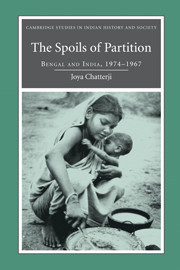Book contents
- Frontmatter
- Contents
- List of maps and illustration
- List of tables
- List of abbreviations
- Glossary
- Preface and acknowledgements
- Introduction
- Part I Hopes and fears
- Part II The Bengal diaspora
- 3 Partition and migration: refugees in West Bengal, 1947–1967
- 4 Staying on: partition and West Bengal's Muslim minorities
- Part III The politics of a partitioned state
- Conclusion
- Appendix
- Bibliography
- Index
4 - Staying on: partition and West Bengal's Muslim minorities
Published online by Cambridge University Press: 25 June 2009
- Frontmatter
- Contents
- List of maps and illustration
- List of tables
- List of abbreviations
- Glossary
- Preface and acknowledgements
- Introduction
- Part I Hopes and fears
- Part II The Bengal diaspora
- 3 Partition and migration: refugees in West Bengal, 1947–1967
- 4 Staying on: partition and West Bengal's Muslim minorities
- Part III The politics of a partitioned state
- Conclusion
- Appendix
- Bibliography
- Index
Summary
India's partition was intended to create a strong, homogeneous nation, capable of being governed effectively from the centre, a goal which could be achieved only by excising from India its Muslim-majority regions. In a parallel but differently motivated campaign, the Hindus who pressed for Bengal's partition wanted to cut out territories in which Muslims were a threatening majority, even if this meant sacrificing the economic viability of their new province. But these partitions were inevitably incomplete. Given the complex history of Muslim migration, conversion and settlement in the sub-continent, dividing India on this basis still left large Muslim minorities inside India, and particularly in the Bengal delta, where, as far back as the twelfth century, many Muslims had settled. By 1947, Bengal had one in three of the sub-continent's Muslims. Those who pressed for the new state of Bengal wanted lines of partition which ensured there were as few Muslim-majority tracts inside their new province as possible and the least number of Muslims. In fact, Radcliffe's Award left over 5 million Muslims in West Bengal, almost a quarter of the new province's total population, and 15 per cent of all the Muslims in the new India. It could hardly have done otherwise.
Partition foisted change – sudden, dramatic and irreversible – upon these 5 million Muslims. Historians concerned with counting the human cost of partition have concentrated on refugees driven across borders by the painful and violent vivisection which it entailed.
- Type
- Chapter
- Information
- The Spoils of PartitionBengal and India, 1947–1967, pp. 159 - 208Publisher: Cambridge University PressPrint publication year: 2007

